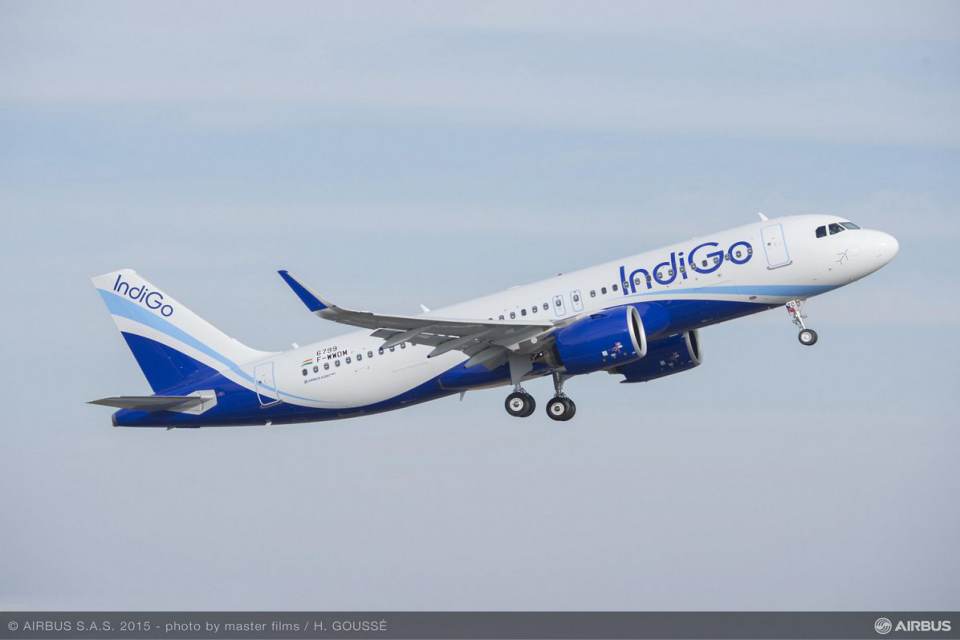Airlines
Indigo’s flight reports engine stalls warning mid-air as big jet creates ‘wake-turbulence’
Indigo’s flight reports engine stalls warning mid-air as Boeing 777 creates ‘wake-turbulence’

An Airbus A320 operated by IndiGo experienced an uncommon occurrence on Monday while passing over the Guwahati to Mumbai route at a height of about 36,000 feet. The captain detected an Engine 1 stall warning signal that suddenly disappeared. Due to a larger jet of a Boeing 777 aircraft traveling in the opposite way of Indigo’s A320 aircraft, which generates “Wake Turbulence” mid-air, IndiGo flight 6E-6812 briefly had an engine 1 stall warning signal, an official told ANI.
The IndiGo plane was traveling well to its destination after seeing wake turbulence from an Emirates Boeing (B-777) large airliner. At roughly 6:32 am, an IndiGo flight with a destination of Mumbai departed from Guwahati airport on time. The huge jet aircraft that crossed in the opposite direction of the Indigo aircraft caused the “wake turbulence,” which is termed.
Four myths about air turbulence. How Dangerous Is It?(Opens in a new browser tab)
The major US-based transportation regulator, the Federation Aviation Administration (FAA), explicitly states that wake turbulence can occasionally be insignificant or catastrophic.
The weight, wingspan, size, and proximity to the original aircraft, as well as the point of the vortex collision, determine the impact of the encounter.
Wake turbulence can impose rolling moments that are greater than the roll-control authority of approaching aircraft, thereby endangering the safety of the passengers and damaging the aircraft. When passing through another aircraft’s wake, pilots should always be alert for the risk of encountering wake turbulence and change their flight route appropriately.
There was no harm done to the plane or the passengers, and the airline’s company reported the occurrence to India’s aviation oversight agency, Director General Civil Aviation (DGCA).

Airlines
An A320 plane flew for 28 minutes with both pilots asleep

In a startling incident, an Airbus A320 operated by an Indonesian airline, Batik Air, flew for a harrowing 28 minutes with both pilots asleep at the controls.
The alarming event unfolded on Batik Air Flight 6723, carrying 153 passengers, en route to Soekarno–Hatta International Airport in Jakarta. The saga began when the first officer allowed the captain to take a nap, only to fatigue himself, attributing his drowsiness to caring for his one-month-old twins. As the pilots dozed off, the aircraft veered off-course, prompting concerns from air traffic control (ATC) who lost contact with the flight 90 minutes into its journey.
Despite the pilots being unresponsive for nearly half an hour, ATC managed to track the aircraft using radar as it covered a staggering 210 nautical miles, equivalent to the distance between New York and Washington, D.C. The captain eventually woke up, realizing the perilous situation and rousing his co-pilot.
After correcting the flight path, the captain attributed the radio silence to a “communication problem,” and the plane eventually touched down safely in Jakarta. However, the incident sparked widespread concern and investigation by Indonesia’s transport ministry.
A preliminary report revealed that the second-in-command had not rested adequately before the flight, shedding light on the potential dangers of pilot fatigue. While the identities of the pilots remained undisclosed, the incident underscored the critical importance of ensuring crew members are well-rested and fit for duty.
Despite the gravity of the situation, the swift actions of the awakened captain averted disaster, emphasizing the necessity for robust safety protocols and measures within the aviation industry.
Airlines
Ex-Cathay Pacific A330-300 Destroyed by Fire during Long-Term Storage at Spain

In a dramatic turn of events, an ex-Cathay Pacific Airbus A330 met a fiery end at Ciudad Real Airport in Spain. The aircraft, with a distinguished service history spanning 28 years, was resting in long-term storage at the airport when disaster struck.
Reports emerged detailing the unfortunate incident, painting a picture of destruction and chaos. The once majestic A330, bearing the serial number MSN113, became engulfed in flames while undergoing dismantling procedures. What began as a routine process turned into a nightmare as a fire erupted in the aircraft’s tail section, quickly spreading to consume the entire fuselage.
Emergency responders, including the Civil Guard, medical teams, and law enforcement personnel, swiftly descended upon the scene to contain the inferno. Despite the intensity of the blaze, their coordinated efforts prevented any injuries among both the public and the brave individuals working to quell the flames.
By mid-afternoon, the Ciudad Real fire service declared victory over the fire, announcing its successful extinguishment. However, the aftermath left behind a trail of questions and concerns. Authorities launched an investigation into the cause of the blaze, with initial findings shrouded in mystery.
The head of the airport expressed astonishment at the unprecedented event, highlighting it as the first instance where airport infrastructure had to grapple with such a significant fire-related challenge. As the investigation unfolds, the aviation community awaits answers, hoping to shed light on the circumstances leading to the demise of the retired Airbus A330.
Airlines
Air India’s last VVIP Boeing 747 now found a new home in USA

In a symbolic transition marking the end of a storied chapter in aviation history, Air India bid farewell to its last remaining Boeing 747-400 jumbo jetliners, once revered for ferrying dignitaries including prime ministers, presidents, and vice presidents.
The sale of these iconic aircraft to AerSale, a company based in the United States, signals the closure of a remarkable era for the airline.
The decision to part ways with the Boeing 747s was driven by practical considerations. Tata Group, the new custodian of airindia flights, deemed these majestic planes uneconomical to operate in today’s aviation landscape. As such, out of the four sold, two will be repurposed into freighters, while the remaining pair will be meticulously disassembled to harness their valuable parts.
The transaction, orchestrated by Mumbai-based Vman Aviation Services, underscores the strategic shift in Air India’s fleet management strategy under its new ownership. Tata Group’s decision to divest from the 747s reflects a commitment to optimizing operational efficiency and aligning with contemporary industry standards.
Skytech-AIC, a UK-based remarketing firm engaged by Tata Group, facilitated the sale of these iconic aircraft, marking the conclusion of their illustrious service with Air India. The airline’s last flight featuring the Boeing 747 took to the skies between Delhi and Mumbai in March 2021, encapsulating decades of distinguished service and indelible memories.
The allure of used aircraft parts continues to resonate across the aviation sector, offering operators a cost-effective alternative without compromising on quality or performance. The transfer of these aircraft to AerSale not only ensures their continued utility but also underscores the enduring legacy of Air India’s fleet.


























